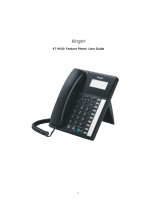
Operating Manual 11
1.3.41 Executive Busy Override—Outside (CO) Line .................................................................. 85
1.3.42 Executive Busy Override Deny ......................................................................................... 86
1.3.43 Extension Feature Clear ................................................................................................... 87
1.3.44 Extension Lock.................................................................................................................. 87
1.3.45 External Feature Access (EFA)......................................................................................... 89
1.3.46 Flash/Recall ...................................................................................................................... 89
1.3.47 Hands-free Answerback.................................................................................................... 90
1.3.48 Hands-free Operation ....................................................................................................... 91
1.3.49 Headset Operation............................................................................................................ 92
1.3.50 Hot Line ............................................................................................................................ 93
1.3.51 Intercom Call..................................................................................................................... 94
1.3.52 Line Access, Outside (CO) Line—SUMMARY.................................................................. 95
1.3.53 Line Access, Automatic..................................................................................................... 96
1.3.54 Line Access, Outside (CO) Line Group............................................................................. 97
1.3.55 Line Access, S-CO Line.................................................................................................... 98
1.3.56 Live Call Screening (LCS) (Voice Mail APT Integration only) ........................................... 99
1.3.57 Local Carrier-based Voice Mail Service.......................................................................... 102
1.3.58 Lockout ........................................................................................................................... 103
1.3.59 Log-in/Log-out................................................................................................................. 104
1.3.60 Message Waiting ............................................................................................................ 105
1.3.61 Message Waiting for Another Extension ......................................................................... 108
1.3.62 Message Waiting for Another Extension Lock ................................................................ 109
1.3.63 Microphone Mute ............................................................................................................ 110
1.3.64 One-touch Dialing ........................................................................................................... 110
1.3.65 Operator Call................................................................................................................... 111
1.3.66 Paging—SUMMARY ....................................................................................................... 112
1.3.67 Paging—All Extensions................................................................................................... 113
1.3.68 Paging—All Extensions & External ................................................................................. 113
1.3.69 Paging—External ............................................................................................................ 114
1.3.70 Paging—Group ............................................................................................................... 114
1.3.71 Paging and Transfer ........................................................................................................ 115
1.3.72 Paging Answer ................................................................................................................ 116
1.3.73 Paging Deny ................................................................................................................... 116
1.3.74 Paralleled Telephone....................................................................................................... 117
1.3.75 Personal Speed Dialing .................................................................................................. 117
1.3.76 Power Failure Transfer .................................................................................................... 119
1.3.77 Pulse to Tone Conversion ............................................................................................... 119
1.3.78 Redial, Last Number ....................................................................................................... 120
1.3.79 Redial, Saved Number.................................................................................................... 120
1.3.80 Room Monitor ................................................................................................................. 121
1.3.81 Secret Dialing ................................................................................................................. 123
1.3.82 System Speed Dialing .................................................................................................... 124
1.3.83 Time Service................................................................................................................... 125
1.3.84 Timed Reminder ............................................................................................................. 126
1.3.85 Toll Restriction (TRS) ...................................................................................................... 128
1.3.86 Toll Restriction (TRS) Override by Account Code........................................................... 128
1.3.87 Two-way Recording in the VPS (Voice Mail APT Integration only).................................. 128
1.3.88 Voice Mail Integration...................................................................................................... 129
1.3.89 Voice Mail Transfer (Voice Mail APT Integration only)..................................................... 132
1.3.90 Walking COS .................................................................................................................. 133




















